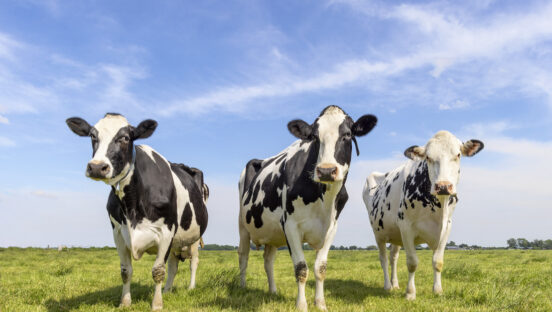
What if your top-line revenue remained flat and your bottom-line profit grew by 3% to 5%? How do successful independents and chains grow so rapidly? The answer: through menu engineering.
Menu engineering is a sophisticated study that observes how restaurant patrons make item selections, and then designs or engineers the menu to encourage consumers to select certain items over others. Well-engineered menus sell higher-gross-profit items that satisfy the consumer and supply incremental gross-profit dollars to the restaurant operator. If you consider your menu nothing more than a decorative price list, you’re missing opportunities. Your menu is your most powerful merchandising tool. Your menu reflects what makes your pizzeria special and profitable.
Menus perform three primary functions: First, they position the restaurant. As an example, paper menus in a carryout pizzeria are appropriate and smart; consumers can take them home for easy reordering. But a paper menu in a white tablecloth pizzeria with an extensive Italian wine list confuses customers. Second, menus merchandise; they offer choices to the consumer. And, finally, they sell. The purpose of menu engineering is to sell the items you want to sell.
Picture that you’re out to dinner with family and friends. The wait staff visits the table to ask if you made your choice yet. You and your tablemates have been sipping drinks and catching up, but the social pressure to place an order is high, so you grab the menu, scan the pictures and text, and quickly pick an item. Most people dine out primarily to enjoy their time, so many items will satisfy their food desires. Menu engineering encourages consumers to buy the items that your kitchen staff executes well and that drive additional profit.
Typical Pizza Menu
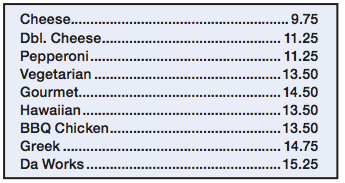
PROBLEMS:
• Makes price most important element
• Lists lowest to highest price
• Does not make use of most important placement areas: first and last
The first step of engineering your menu: Calculate your theoretical food cost. Simply add the value of all ingredients in a particular dish and divide by the selling cost (see graphic below). Once you determine your cost for each, you must rank them—not by food cost percentage, but by gross profit dollar contribution.
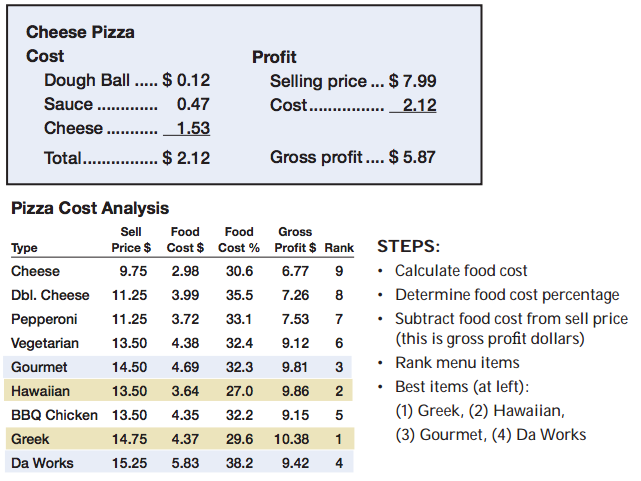
Food cost percentage is an interesting management tool, but it doesn’t determine profitable operations. Ask your accountant or your banker: You take dollars to the bank, not percentages. Excellent menu engineering that satisfies customers’ needs and delivers additional gross profit to you is the key to success. Menu engineering is an established and important study, and many of its teachings and techniques are used by chain restaurants. They pour tens of thousands of dollars into consumer studies, focus groups, eye movement studies, etc., to determine why consumers select the items they buy. Below are some simple improvements you can make to your own menu.
Improved Pizza Menu
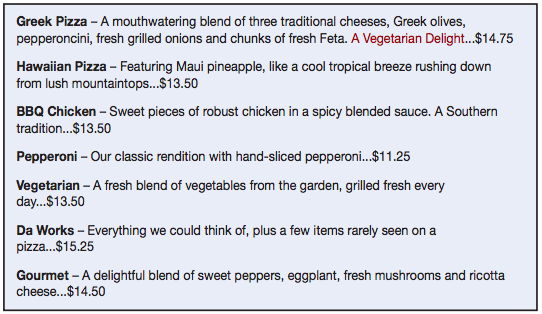
Elements of Menu Success
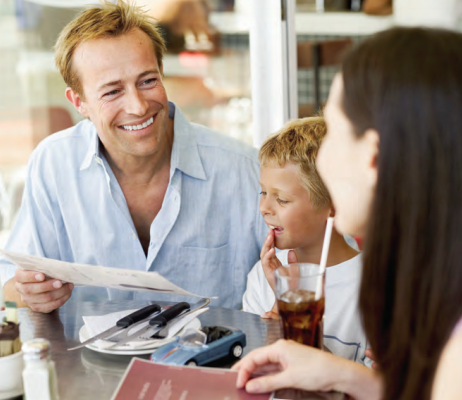 Placement. When consumers choose items from a menu they don’t read, they scan. Statistics show that the most chosen items are in the first and second, and the last and next to last, spots on a list. In the above example, selection behavior predicts consumers will choose, in order, Greek, Hawaiian, Gourmet and Da Works. This corresponds exactly to the ranking in the food cost analysis.
Placement. When consumers choose items from a menu they don’t read, they scan. Statistics show that the most chosen items are in the first and second, and the last and next to last, spots on a list. In the above example, selection behavior predicts consumers will choose, in order, Greek, Hawaiian, Gourmet and Da Works. This corresponds exactly to the ranking in the food cost analysis.
Vegetarian options are very important today. The Greek Pizza is vegetarian, as is the Vegetarian pizza “buried” in the middle of the menu. Therefore, a consumer who scans for a vegetarian option finds the Greek first and chooses it. This creates a $10.38 gross profit, vs. the $9.12 of the regular Vegetarian. The consumer gets what he wants, and you make an additional $1.26. Project the effect on your bottom line if you made an additional $1 gross profit on every order. This is the power of menu engineering.
Review your current menu; chances are, the first item you feature is cheese pizza, as shown in the Typical Pizza Menu shown on the previous page. Plain pizza is typically a low-profit item, as it is the commodity, along with pepperoni pizza, that drives your coupon shoppers. Additionally, children, who do not even read the menu, usually choose cheese pizza. In featuring the cheese first, you give up your highest-gross-profit placement for a low-profit item that the key buyer does not even notice.
Callouts. This is a simple change you can make: Notice the red color used to call out “vegetarian” on the Greek Pizza. Boxes around items also drive eyes to that item. Feature a “House Special” in bold text and surrounded by a box (see the example at right). Boxes placed in the lower left-hand corner draw the eye; this is a hot spot, so use it wisely. Many restaurants feature a favorite item in this spot; it should be a high-gross-profit contributor, not just an item your patrons like. Promotion of a low-gross-profit item increases your chance of lowering your overall margin.
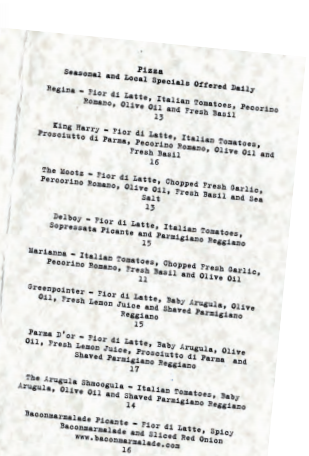 Descriptions. Another technique used to drive sales: the description. Reread the description on the previous page of the Greek and the Vegetarian. Which would you choose? Again, gently encourage the patron to choose the item that satisfies both you and them.
Descriptions. Another technique used to drive sales: the description. Reread the description on the previous page of the Greek and the Vegetarian. Which would you choose? Again, gently encourage the patron to choose the item that satisfies both you and them.
Pictures. Yes, people eat with their eyes. Enticing color pictures of your food, not generic pizza shots, sell products. However, menus have limited real estate, so you cannot feature images of all items (except online). Again, choose beautiful pictures of a limited number of high-gross-profit items. Use only color pictures—no black-and-white shots. If you print your carryout menu in one or two colors, do not show pictures. Food in one color looks terrible; either use full color or don’t include pictures at all. Likewise, do not use poor-quality photos. Most people have digital cameras today, but you shouldn’t use them. Food photography is an art; if you are not prepared to spend the money to hire a professional photographer and food stylist, don’t use pictures. Photos only work when done correctly; in this case, less is more, so if you don’t have top quality shots, skip it.
Buried prices. Notice where the prices appear on the Improved Pizza Menu on the previous page; they are “buried” in the description vs. appearing in list form at the end after a series of dots. In the Typical Pizza Menu, pizza is listed by lowest price to highest price, so people naturally choose items priced in the middle. Burying prices allows people to buy what they want rather than buy according to price. Especially in groups, people are hesitant to order higher-priced items, as it appears piggish or greedy. Buried prices give customers permission to buy what they want.
Reprints. Many pizzerias are reluctant to reprint menus because of cost and/or because they’re afraid to change prices. When costs spike, sometimes you must raise prices. Pizzeria operators frequently complain they cannot raises prices because they have printed prices on menus that customers have at home in their menu drawers. The simple solution is to print menus with expiration dates, just like coupons. You can always choose to honor “expired menu prices,” but in a case where you have raised prices, you have alerted customers that prices are subject to change. Gas stations never hesitate to change their prices; if the cost of oil rises, they raise the price, frequently that day and never with any notice. Consumers know this and accept it. With digital printing today, you can economically change your menu prices, add new items or offer specials by printing smaller quantities of menus more frequently. This more flexible approach keeps your menu fresh for regular customers.
Menu engineering is a topic that takes years to research and perfect; there is much more complexity than can be discussed in a short magazine article. However, the tips discussed here are simple to execute and will provide additional profitability with minimal effort. Meanwhile, begin looking at menus more critically—from your competitors and from restaurants that you visit; you will begin to see that some use these techniques and profit from their inclusion. Try a few of the ideas and see if they work for you; you have nothing to lose but extra profit.

